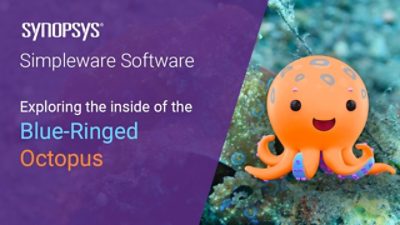The Making Of: Exploring the Inside of the Blue-Ringed Octopus Video
Posted on 25 January 2021 by Jessica James
The blue-ringed octopus is a fascinating creature, and a great subject for introducing children to the ideas behind 3D imaging technologies. We have recently put together our first Video for Kids, that shows how the octopus was scanned, modeled in Simpleware software, and 3D printed. Why did we do this, and how did the video come together through different projects over the years?
Researching the Blue-Ringed Octopus
The origins of the project came through Dr. Julian Finn at Museums Victoria and his research into the blue-ringed octopus. On a dive in 1996, Dr. Finn found a female blue-ringed octopus with eggs and took it back to the aquarium at the University of Melbourne Zoology Department. He preserved one hatchling in Bouin’s solution and years later started collaborating with Dr. David Ackland of the University of Melbourne, who was able to scan the specimen using a micro-CT to study it further.

Picture of a blue-ringed octopus hatchling (courtesy Dr Julian Finn, Museums Victoria)
The original specimen is now part of the Museums Victoria Collections, and is kept in the marine invertebrate collection at Melbourne Museum. Although a photo of the original octopus does not exist, the image above shows an equivalent example of a Hapalochlaena maculosa hatchling, including the bright orange color it has upon emerging from its eggs.
How Simpleware Became Involved
In 2015, we ran a contest for unusual image data that, if chosen, would be turned into an animated video using Simpleware ScanIP. Dr. Ackland submitted his micro-CT data and took first prize out of three total winners, who all received an animation. Dr. Ackland also received a 3D printed model, which he used as a teaching aid for better understanding the blue-ringed octopus.

Dr. Ackland holding a scaled-up 3D print of the blue-ringed octopus
Creating the Blue-Ringed Octopus Animation
Simpleware ScanIP was used to segment the relevant regions of interest (ROIs) of the octopus micro-CT data, including anatomical parts such as the brain and vessels. We then created an animated clip using the Animation toolbox in Simpleware ScanIP, which helps exploring the image data and the final 3D model.

Exploring the inside of the blue-ringed octopus with Simpleware ScanIP
Making the Video for Kids
In the last year, we wanted to create a video as part of Synopsys’ community outreach efforts that could help 6-12-year-olds understand our technology in a fun and relatable way. The video shows how the blue-ringed octopus specimen was obtained, scanned, modeled and animated using Simpleware ScanIP software, and finally 3D printed. We especially wanted to communicate some quite complex technical information in a way that would be accessible to younger viewers.
You can see how the entire process came together in the final video below. We hope that you and your children enjoy it and learn something about the blue-ringed octopus and how science and engineering helped look inside it.
Our hope is that we can do more Videos for Kids in the future to show how image-based modeling can create fascinating and exciting stories that help us understand the world we live in.
Learn More
- Information about the blue-ringed octopus at Museums Victoria
- Watch the animations of our image data contest winners
Acknowledgements
Many thanks to Dr. Julian Finn of Museums Victoria and Dr. David Ackland of the University of Melbourne for their contributions to this project.
Any Questions?
Do you have any questions about Simpleware software or would like to work with us on the next project?




